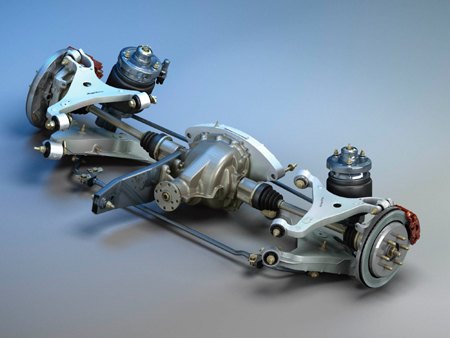Ford: Air Today, Innovation Tomorrow
In Ford's latest ads, Mr. Bill touts The Blue Oval as a tireless automotive innovator. In reality, Ford has seldom, if ever, taken the technological lead. The Model T's accomplishments owe more to its production process than any mechanical advance. Later successes– like the original Mustang and the first Explorers– broke new ground in marketing and style, not engineering. And lest we forget, Ford still relies on relatively unsophisticated engines to propel its products, ceding both fuel efficiency and powertrain refinement to their competitors. Fortunately for Ford's new focus, the company is a real leader in at least one key engineering discipline…
Ask an old-timer about air suspension and they'll regale you with tales of the ill-fated air springs that bedeviled GM, Ford and American Motors cars in the late 50s; springs that left many a model listing like a 17th century sailing ship in a howling gale. But there was a good reason automakers pursued the technology: it held forth the promise of a constant ride height and frequency. In other words, a properly air-suspended vehicle's ride doesn't degrade with a full load of passengers and luggage; the tail won't drag and the headlights won't point at the sky. Air springs can also be precisely tuned, giving chassis designers a greater opportunity to balance ride and handling.
Of the mass manufacturers, Ford alone stepped up, again, later, still, to the challenge. In '84, Ford finally felt confident enough in their technological prowess to [re]introduce a car that glided on air: the Lincoln Mark VII. Ford's luxury division's new model featured air springs at all four corners, a sophisticated electric air pump and dryer system, leak-proof hose connections, and electronic controls to monitor the system and maintain vehicle height. Although the Mark VII was a clear sales winner, its remarkable air suspension was hardly ever mentioned in its advertising, or any other Ford promotion.
In '88, Ford added elements of the Mark VII system to the Continental's underpinnings. The redesigned Lincoln Continental had a full air system, like the Mark, with electronically controlled variable damping and steering effort to boot. In '93, the Mark VIII's air spring system lowered the car's ride height at speed. While a few clever TV ads showed off the benefits for ride comfort and car control, the air suspension technology that made it possible was never mentioned. Ford eventually spread the technology to more mundane cars like the Lincoln Town Car and Mercury Grand Marquis. Every day, thousands of criminals ride to the slammer atop a pair of air springs in a Crown Vic.
Ford's air spring technology also made its way into the company's vast array of SUVs, where it has greater theoretical advantages. These vehicles, designed to carry large loads and tow heavy objects, need the advantages of constant height and ride frequency even more than a luxury coupe. The Lincoln Navigator, for example, can tow up to 8600 lbs. without the slightest degradation of ride height or ride comfort– AND it kneels for easier entry. Other Ford SUVs now have partial air spring systems, from the Expedition to the new Ford Explorer. All benefit from greatly from this advanced technology.
If Ford's looking for a quick and relatively inexpensive way to enhance its reputation for technological proficiency, The Blue Oval could extend their air suspension systems to their light trucks. Although a light truck's rear leaf suspension gives it tremendous load-bearing capabilities, the genre typically rides and handles extremely poorly when empty. Since that's the way most F150s are used most of the time, their drivers end-up constantly shaken and stirred by road irregularities. Air springs, especially at the rear, would allow Ford trucks to maintain a comfortable ride and a level stance, whether fully loaded or completely empty.
Maybe Ford's afraid that pickup drivers enjoying a smooth ride won't think that their truck is 'Ford Tough'. But heavy truck manufacturers rely on air suspension extensively; those 18-wheelers you see cruising the interstate have been riding on air for almost half a century. (In fact, it's rare to find a heavy truck without air springs.) Ford's advertising and marketing departments could capitalize on the heavy-duty and long distance trucker's reliance on air suspension to infuse their air-sprung pickups' image with appropriate machismo.
Perhaps the best proof of Ford's leadership in air suspension is the fact that many of Europe's finest now deploy their own versions of Ford's ground-breaking technology. Jaguar and Land Rover ride on air for the home team, while Mercedes' S-Class has [finally] returned to the air-suspended glory of their '68 300 SEL 6.3. The Volkswagen Audi Group touts the value of their adaptive air suspension for the A8, Bentley GT and Bentley Flying Spur. It's not often that Ford can honestly claim to be at the forefront of an important automotive technology used by the prestige players. It's about time they did.
More by Bob Elton
Latest Car Reviews
Read moreLatest Product Reviews
Read moreRecent Comments
- ToolGuy I might be Batman.
- Lou_BC Well, I'd be impressed if this was in a ZR2. LOL
- Lou_BC This is my shocked face 😲 Hope formatting doesn't fook this up LOL
- Lou_BC Junior? Would that be a Beta Romeo?
- Lou_BC Gotta fix that formatting problem. What a pile of bullsh!t. Are longer posts costing TTAC money? FOOK


































Comments
Join the conversation